Ghee, often referred to as the golden elixir in the culinary world, has been a staple in traditional cooking for centuries. Not just confined to enhancing the flavor of dishes, ghee boasts a multitude of health and beauty benefits that are only beginning to be recognized by the Western world. In this article, we dive deep into the world of ghee, exploring its historical roots, nutritional content, and the myriad ways it can contribute to overall wellness.
Historical Context
Origin and Cultural Significance

Ghee, or clarified butter, has a rich history rooted in ancient India, where it originated and became a staple in dietary and ceremonial practices. The word “ghee” is derived from the Sanskrit word “ghrita”. Its production and use have spread throughout South and South-East Asia, with variations found in parts of the Middle East, and North and East Africa. This clear butter fat is made by heating butter and evaporating the moisture, leaving behind the pure fats. Ghee’s significance extends beyond cuisine into the realms of religion and mythology. Hindu mythology recounts the divine origin of ghee, attributing its creation to Prajapati, further emphasizing its sacred status in Indian culture. Known as “liquid gold” or “sacred fat,” ghee’s origins can be traced back to the domestication of cattle and the consumption of butter in ancient India.
Nutritional Profile
Vitamins and Minerals in Ghee
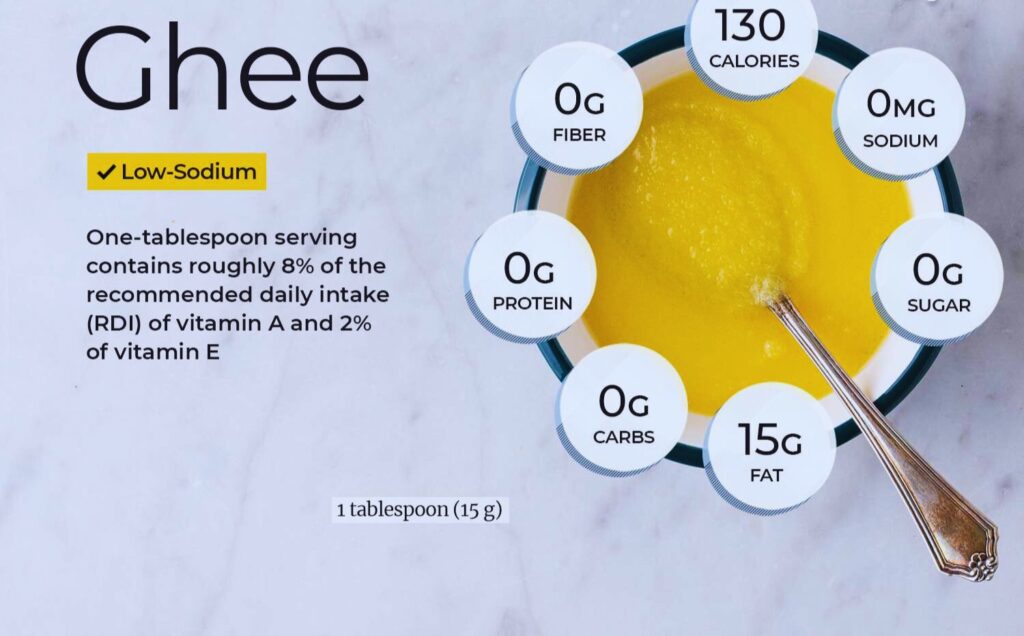
Ghee, or clarified butter, is not only for its rich flavor but also for its nutritional profile. Primarily composed of fats, ghee contains a notable array of vitamins and some minerals. It is especially rich in vitamin A, contributing to immune function, eye health, and skin health. Ghee also provides a decent amount of vitamin E, known for its antioxidant properties that help protect cells from oxidative stress. Additionally, it contains small amounts of vitamin D, which plays a crucial role in bone health and immune function, and vitamin K, essential for blood clotting and bone metabolism.
Furthermore, ghee is a source of omega-3 fatty acids and conjugated linoleic acid, both of which have been linked to health benefits such as reduced inflammation and potential support for weight management. However, it’s important to note that while ghee offers these nutrients, it is very high in saturated fats, and its consumption should be moderated in the context of an overall balanced diet.
Fatty Acids Composition
Ghee is predominantly made up of lipids, with a fat content of approximately 99.5% and a moisture content of less than 1%. The major portion of its lipid profile is constituted by fatty acids, which represent around 85.1% of ghee. Specifically, ghee is rich in saturated fats, with analyses indicating a range of 60-70% saturated fat content. Among the saturated fatty acids (FAs), the most prominent are C4:0, C14:0, C16:0, and C18:0. This profile underscores ghee’s unique nutritional characteristics, distinguishing it from other fats and oils and highlighting its role in dietary patterns.
Health Benefits
Supports Digestive Health
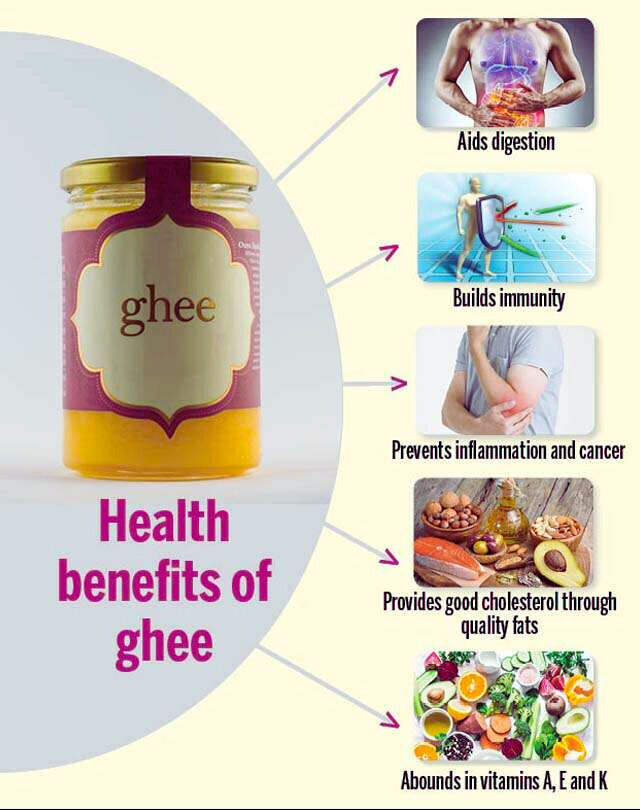
Ghee has several properties that contribute to its beneficial effects on digestive health:
- Stimulates Gastric Acid Secretion: Enhances the body’s ability to digest food more efficiently by stimulating acid secretion in the stomach.
- Regulates and Repairs Intestinal Lining: Ghee contains vital vitamins and minerals that help regulate and repair the intestinal lining, thus maintaining brain health and gut functions.
- Supports Healthy Bowel Movement: By maintaining the health of the gastrointestinal mucosa, ghee supports and regulates healthy bowel movements and inhibits the growth of harmful microbes.
- Improves Nutrient Absorption: Starting the day with ghee can enhance the absorption of nutrients during digestion, providing an overall benefit to digestive health.
Boosts Immune System
Ghee, a type of clarified butter, has been identified as a significant immune system booster. It contains Butyric acid, which is instrumental in the production of T cells within the intestinal tract, thus enhancing the body’s defense mechanisms. Ayurvedic and modern scientific studies both support ghee’s use for its immune-boosting properties, highlighting its role in maintaining and improving health. Additionally, ghee is rich in water-soluble omega-3 fatty acids and essential vitamins such as A, D, K, and E, which further contribute to strengthening the immune system and ensuring its efficient functioning.
Promotes Heart Health
Ghee, a traditional ingredient in many cuisines, may play a role in promoting heart health. Studies have shown that in some populations, such as a rural group in India, individuals consuming higher amounts of ghee had a significantly lower prevalence of coronary heart disease. Additionally, findings suggest that incorporating ghee up to 10% of the diet does not increase the risk of heart disease, even for those who may be predisposed. Ghee is also noted for being rich in omega-3 fatty acids, which are known for their anti-inflammatory properties and potential to protect against heart disease. While there are concerns about ghee’s high saturated fat content, some research highlights that traditional consumption of ghee butter may correlate with lower risks of heart disease.
Anti-inflammatory Properties
Ghee has been recognized for its anti-inflammatory properties, which are beneficial for reducing inflammation in various parts of the body. Studies have specifically shown ghee’s effectiveness in reducing inflammation in conditions such as acute pancreatitis, where it can soothe inflammation in pancreatic and lung tissues. Moreover, ghee’s role in traditional Ayurvedic medicine includes its use for treating burns and swelling, thanks to its significant anti-inflammatory properties.
Beauty and Wellness
For Glowing Skin

Ghee, a clarified butter, is renowned not only for its culinary uses but also for its numerous skin benefits. It can be a natural and effective component in your beauty and wellness routine to achieve glowing skin. Here are some ways to incorporate ghee into your skincare:
- Direct Application: Apply two to three drops of pure ghee directly on your skin, including the under-eye area, to help soften and enhance skin glow.
- Overnight Treatment: Massage ghee lightly onto your face and leave it on overnight. This can result in youthful, glowing skin by morning.
- DIY Face Mask: Combine 2 tsp of pure ghee, 1 tsp of honey, and ½ tsp each of turmeric and besan (gram flour) to create a nourishing face mask. This mixture can brighten the skin and add a natural glow.
- Makeup Remover: A blend of one teaspoon of ghee with a drop of vitamin E oil can be an effective and gentle makeup remover, especially around the delicate eye area.
Regular use of ghee, both topically and through consumption, can aid in hydrating the skin, adding to its glow and overall health.
For Luscious Hair
Ghee has been touted for its potential benefits in promoting luscious, healthy hair. While scientific research might not be extensive, anecdotal evidence and traditional uses suggest that ghee could be a valuable addition to your hair care routine. Here are a few ways ghee might benefit your hair:
- Hair Growth and Conditioning: Ghee is believed to promote hair growth and condition the hair, making it thicker and healthier, as supported by anecdotal evidence.
- Scalp Nourishment: Regular massages with ghee can boost blood circulation in the scalp, offering a spa-like experience while nourishing the scalp and potentially enhancing hair health.
To incorporate ghee into your hair care routine, consider massaging a small amount into your scalp and hair, leaving it on for a period before washing it out with shampoo. However, it’s important to proceed with caution and conduct a patch test, as everyone’s hair and scalp react differently to natural products.
Culinary Uses
Enhancing Flavors
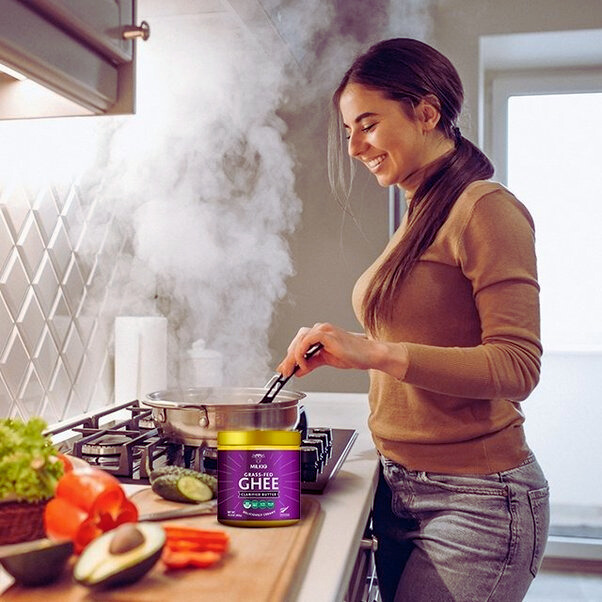
Ghee, with its rich, nutty flavor, can enhance a wide range of dishes beyond just frying. Its high smoke point makes it versatile for various cooking methods. Here are some culinary uses for ghee that go beyond frying:
- Roasting: Ghee is excellent for roasting vegetables and meats, giving them a delicious, crispy exterior and a rich flavor.
- Traditional Indian Dishes: Utilize ghee in a variety of Indian recipes such as butter chicken, lamb korma, and navratan korma for authentic flavors.
- Sautéing: Use ghee to sauté vegetables, meats, or spices. Its ability to withstand high heat without burning ensures perfectly sautéed ingredients every time.
- Baking: Substitute ghee for butter or oil in baking recipes for a unique, rich taste. It works exceptionally well in pastries and breads.
- Spreading: Ghee can be spread on toast, pancakes, or waffles as a flavorful alternative to butter.
- Dressing: Whisk ghee into dressings or sauces to add depth of flavor to salads or dishes.
- Seafood Recipes: Incorporate ghee into seafood dishes for a subtle, buttery taste that complements the natural flavors of fish and shellfish without overpowering them.
Ghee’s versatility in the kitchen goes far beyond frying, making it a valuable ingredient for enhancing flavors across a variety of dishes.
A Healthier Alternative to Cooking Oils
Exploring healthier alternatives to conventional cooking oils can enrich your culinary experiences while contributing to a more nutritious diet. Among these alternatives, certain oils and fats stand out for their beneficial properties and versatility in cooking:
- Avocado Oil: Praised for its high smoke point, making it ideal for high-heat cooking methods like frying and sautéing. It’s also rich in monounsaturated fats, which are good for heart health.
- Ghee: Clarified butter and ghee is another excellent option. It can withstand high cooking temperatures and adds a rich, nutty flavor to dishes. It’s also lactose-free, making it a suitable choice for those with lactose intolerance.
- Coconut Oil: Known for its medium-chain triglycerides (MCTs), which can support metabolism. While it’s great for baking and medium-heat cooking, it’s best used in moderation due to its high saturated fat content.
- Extra Virgin Olive Oil: A cornerstone of the Mediterranean diet, extra virgin olive oil is excellent for dressing salads and low-heat cooking. It’s packed with antioxidants and monounsaturated fats.
When choosing a healthier cooking oil, consider the type of cooking you’re doing and the flavor you want to achieve. Alternatives like avocado oil, ghee, coconut oil, and extra virgin olive oil not only offer nutritional benefits but also enhance the flavors of your dishes.
Sustainability
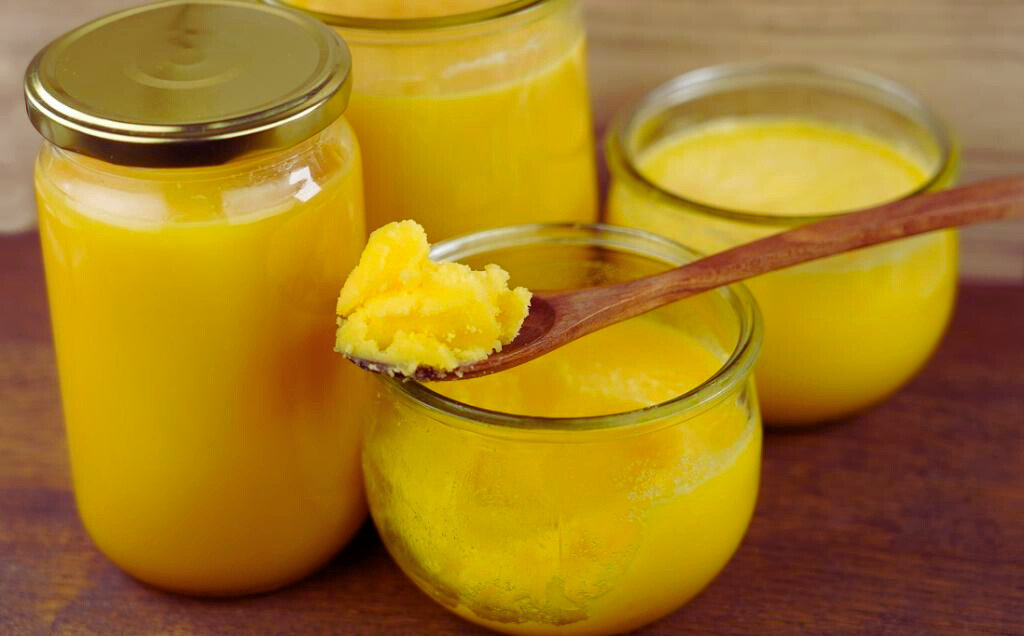
Ghee’s sustainability as a dietary fat encompasses both environmental and nutritional aspects. Dietary fats, including ghee, are essential for a healthy diet but their production has environmental impacts. Ghee, specifically, is a by-product of milk, with its production involving the clarification process that separates milk solids from the fat, resulting in a pure butterfat product. This process utilizes the milk more efficiently, potentially reducing waste.
The environmental impact of ghee production also includes considerations of air emissions and pollution related to the dairy industry. The production processes of edible oils and ghee can affect air quality, contributing to pollution. However, on a positive note, ghee residue, a by-product obtained during ghee production, has been evaluated as a green solvent, suggesting potential for environmentally friendly applications.
In terms of dietary sustainability, ghee provides a high-energy, nutrient-dense option. It is rich in fat-soluble vitamins and fatty acids essential for human health. However, sustainability also involves ethical considerations. Ghee is an animal product, and its production is linked to the dairy industry, which has concerns regarding animal exploitation.
Choosing ghee for its nutritional benefits and potential to reduce waste highlights the importance of considering both environmental impact and ethical concerns in the pursuit of sustainable dietary choices.
How to Choose
Organic vs. Conventional Ghee
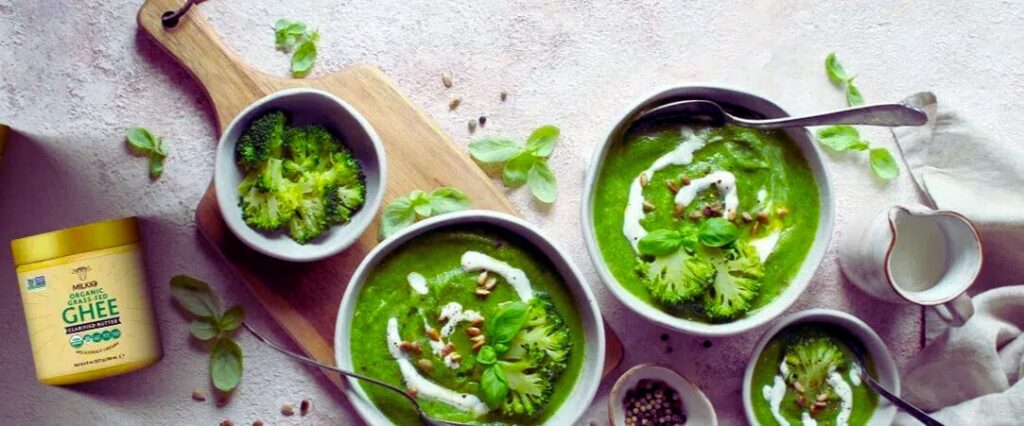
Choosing between organic and conventional ghee involves understanding their differences in terms of production standards, health benefits, and environmental impact. Organic ghee is made from the milk of cows that are fed organic feed and grazed on organic pastures, ensuring no harmful chemicals or pesticides are present in the final product. This process not only benefits your health by avoiding chemicals and pesticides but also supports sustainable farming practices.
Organic ghee is recognized for being superior in terms of nutritional value, containing short-chain fatty acids like butyric acid, which can reduce inflammation and boost the immune system. Moreover, it is easier for babies to digest, providing an energy boost with its nutrient-rich profile.
When picking the right ghee, consider looking for products made from high-quality ingredients, such as organic or grass-fed butter, to ensure you are choosing a healthier, more sustainable option. Ultimately, opting for organic ghee not only supports your health but also promotes environmentally friendly farming practices.
Grass-fed: The Best Choice?
Choosing ghee made from grass-fed cows is widely regarded as the best option for several compelling reasons:
- Nutritional Superiority: Grass-fed ghee is richer in essential nutrients like omega-3 fatty acids, which are beneficial for heart health.
- Digestive Benefits: It is lactose and casein-free, making it easier to digest and a suitable choice for people with sensitivities to dairy.
- High Smoke Point: Ghee has a higher smoke point compared to butter, making it a safer option for cooking at high temperatures.
- Long Shelf Life: It offers a longer shelf life, ensuring that you can store it for extended periods without spoilage.
- Rich in Vitamins: Contains vital vitamins A, D, E, and K, along with nourishing the skin both inside and out.
- Superior Taste and Nutritional Value: Grass-fed ghee is often described as having a superior taste and higher nutritional value compared to conventional ghee.
In conclusion, grass-fed ghee is the preferred choice for those seeking the healthiest and most flavorful option, benefiting from its rich nutritional profile and culinary versatility.
DIY Ghee
Making Ghee at Home
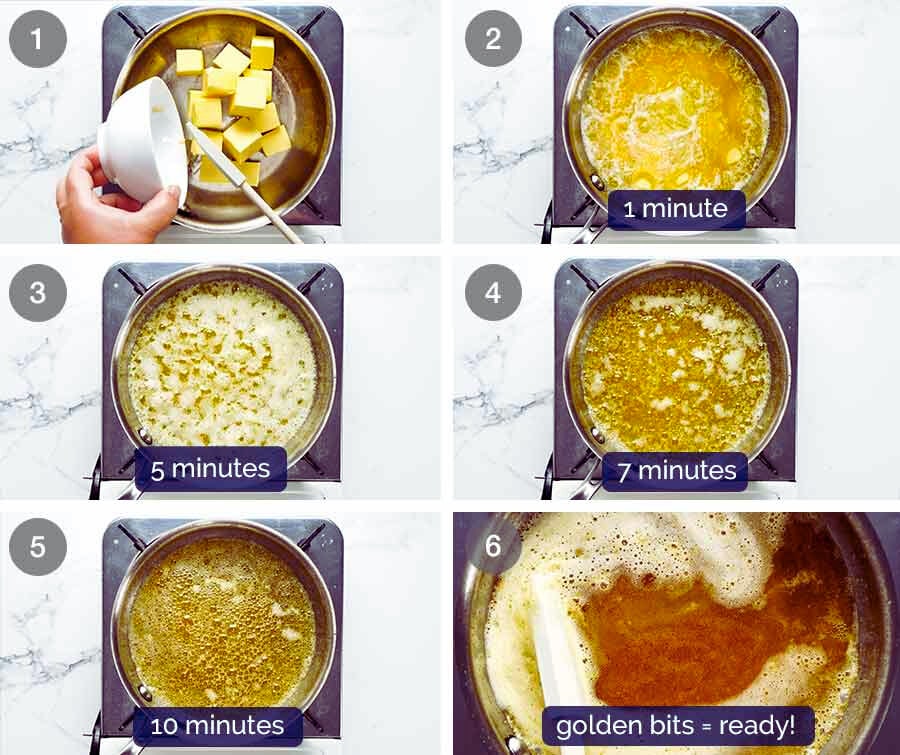
Making ghee at home is a simple process that involves gently heating butter to separate the milk solids from the clear fat, resulting in a nutty-flavored, lactose-free fat that’s perfect for cooking at high temperatures. Here’s a condensed guide:
- Start with Quality Butter: Use about a pound of unsalted, high-quality butter. Organic or grass-fed butter is preferred for the best flavor and health benefits.
- Melt the Butter: Place the butter in a heavy-bottomed pan and melt over medium-low heat.
- Simmer and Skim: As the butter melts, it will separate into three layers. Let it simmer on low heat. Foam will appear on the top – skim it off.
- Watch for Clarity: Continue cooking until the milk solids settle at the bottom and the middle layer becomes clear golden liquid. This indicates the ghee is almost ready.
- Strain and Store: Remove the pan from heat. Strain the ghee through a fine-mesh sieve or cheesecloth into a clean jar to remove the milk solids. Allow it to cool before sealing.
Ghee can be stored at room temperature or refrigerated and is perfect for frying, sautéing, or as a spread.
Conclusion
Ghee, a clarified butter, is celebrated for its rich, nutty flavor and numerous health benefits. It stands out due to its high smoke point, making it an ideal choice for cooking, and its storability without refrigeration. Ghee is packed with fat-soluble vitamins A, D, E, and K, and essential fatty acids, promoting a healthy immune system, aiding in digestion, and potentially supporting weight management. Its lactose-free nature also makes it a suitable alternative for those with lactose intolerance. The unique composition of ghee, including butyric acid and linolenic fatty acids, contributes to its health-enhancing properties, such as strengthening the immune system and supporting heart health. Ghee encapsulates a balance between tradition and modern nutrition, offering a versatile and beneficial addition to a balanced diet.
Read also: What Are the Characteristics of the Particles of Matter?
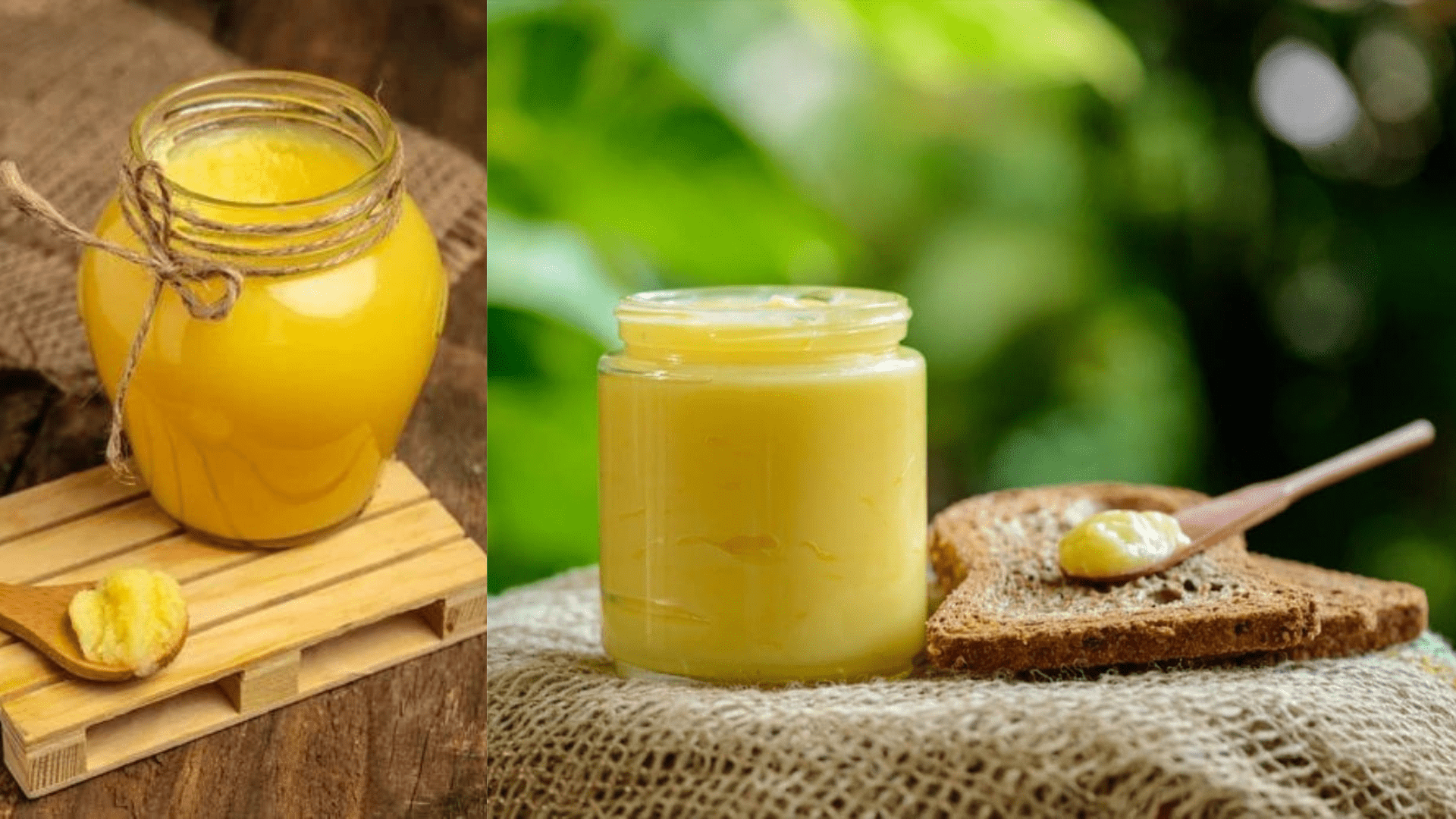




Thank you for reaching out! If you have any specific questions or topics in mind, please feel free to share them, and I’ll do my best to assist you. Whether you’re curious about a particular technology, scientific concept, literary work, or anything else, I’m here to provide information, advice, or engage in a discussion. Don’t hesitate to let me know how I can help you further!